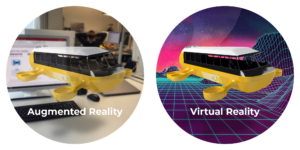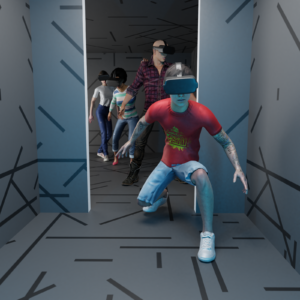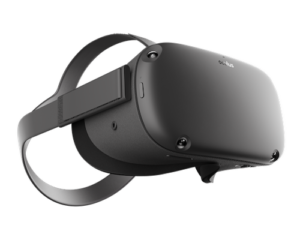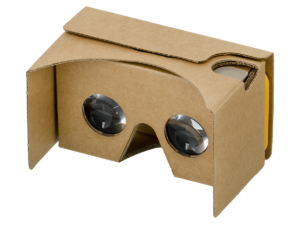Your XR specialists
Enterprise XR for your business
Virtual Discovery AG is your expert for mixed reality experiences, virtual reality apps, multiplayer virtual reality arenas, branded games, serious games, interactive visualizations and immersive training as well as e-learning.
By developing our own platform for multiplayer co-location XR, we have managed to reduce complex development processes to a minimum. This allows us to develop Virtual Reality, Augmented Reality and Mixed Reality for your company in a cost-effective, fast and profitable way – individually tailored to your needs.
As ambassadors for ultra-mobile standalone VR headsets, we offer VR solutions with maximum freedom of movement without cables.

XR FAQ
Here you will find the most frequently asked questions and answers about virtual reality in relation to Virtual Discovery’s services. Please do not hesitate to contact us if you have any further questions on the subject of virtual reality. We will advise you without obligation.
„Motion sickness“ or, in the context of virtual reality, „simulator sickness“ refers to a phenomenon that affects about half of all users of VR experiences. This is nausea and disorientation when using experiences that are associated with movements that do not take place in reality. For example, triggered by watching a virtual roller coaster ride while sitting or standing. Virtual Discovery consistently prevents the occurrence of simulator sickness through exact tracking, natural motion sequences, high frame rates, mixed reality worlds and room scale or world scale virtual reality. World Scale Virtual Reality.
Augmented reality is reality extended by virtual, computer-generated elements. Augmented reality is preferably used wherever the perception of reality needs to be supplemented by meaningful additions and „helpers“. Typical AR applications are navigation systems on head-up displays in cars, overlays of map and geo-information in connection with a mobile phone compass or funny stickers or image transformations for messenger apps. Image transformations for messenger apps. Both Apple and Google have now developed AR core libraries that enable developers to access smartphone cameras to determine the relative position in space.

Virtual reality, on the other hand, is the complete replacement of reality with a computer-generated scenario. If the virtual world is supplemented by elements in the real world (e.g. obstacles in a VR arena), this is called „Mixed Reality“. Virtual Discovery specialises in the development of virtual reality applications, but can also develop augmented reality apps on request. The affinity of the technologies enables flexible development for both VR and AR or MR.

Virtual Discovery combines the virtual with the physical world in many virtual reality experiences. This involves, for example, walls or simple obstacles that can be experienced haptically but look completely different in VR. We call the perfectly coordinated elements of virtual and physical reality as well as the natural freedom of movement „mixed reality“.
XR = extended reality, more rarely also „cross“ reality. XR is a collective term for the symbiosis or combination of the real and virtual worlds. The term includes augmented reality, virtual reality and mixed reality.
Many other providers of so-called VR experiences refer to 360° recordings as virtual reality. However, 360° recordings are no more than static images or videos that allow a maximum of 3 degrees of freedom (3DOF) of movement. In order to create the realistic impression of total immersion, however, at least 6 degrees of freedom (6DOF) are required for the head. Make a non-binding appointment for a live demo and we will show you what virtual reality really means and how you can benefit from it.
You have probably already heard of a “cardboard” or VR glasses for smartphones. With this simple technology, it is possible to use a smartphone as a playback device for 360° content and simple VR applications. However, this highly reduced and so-called “VR” technology is limited to 3 degrees of freedom (3DOF). With this restriction, you can only rotate, tilt or incline your head. Your head remains in the same place regardless of actual movements. Movements of the upper body, e.g. forwards or backwards, are completely ignored. This makes it impossible to look around a three-dimensional object and thus appears very unnatural. With the addition of 3 further degrees of freedom, 6DOF is made possible, which corresponds to today’s definition of “virtual reality”. With 6DOF, the head movements in space are registered in the defined tracking area, which makes it possible to look around a three-dimensional object and, for example, view its back. Only with 6DOF can total immersion be created, giving the viewer the illusion that he or she is actually in a virtual reality.
![]()
Since 2019, more and more virtual reality devices have been offered that have so-called inside-out tracking. This refers to an optical tracking system that uses one or more cameras installed in the HMD to transmit the relative head position, measured against the surrounding space, with 6 degrees of freedom into the VR experience. This results in the decisive advantage that the virtual space is not limited by external sensors. With inside-out tracking, large-scale virtual reality worlds can be created that do not require any external sensors.
![]()
With outside-in tracking, the HMD itself does not have active sensors that enable 6 degrees of freedom. With outside-in tracking, the HMD is only equipped with passive markers or simple sensors that determine the relative position in space in combination with external light sensors or cameras. The big disadvantage of outside-in tracking is that for large-scale VR experiences, several expensive external light emitters or cameras have to be used to seamlessly detect head and body movements across the entire surface. The size of the VR world is always limited to the position of the external sensors.

HMD stands for “Head Mounted Display” and describes the virtual reality devices commercially available today, which consist in particular of a high-resolution display, two lenses and sensors for measuring head movements. A distinction is made between HMDs for connection to computers and standalone HMDs, which already have the hardware necessary for VR built into a compact housing.
In order for the movements of the head and hands in the virtual world to be interpreted correctly, high-frequency sensors must transmit the movement data to a computer with the lowest possible latency. The measured movements are directly applied to virtual instances. For example, the head movement is directly applied to the movement of the virtual camera, which moves analogously to the head in virtual reality.
In both cases, these are descriptions of the available tracking range, i.e. the range in which the player’s movements (primarily head and hands) can be measured. Room Scale limits the tracking range to the size of the room. As a rule, this size is limited by the position of external sensors or cameras. World Scale, on the other hand, is boundless tracking that is not limited to a specific area.
The word immersion comes from Latin (immersio) and means “immersion”. In the context of virtual reality, immersion means that the user of the VR experience accepts its simulated reality and perceives it as real. Immersion in virtual reality can only occur if the HMD and, if applicable, the hand controllers have 6 degrees of freedom. Immersion cannot occur or can only occur to a very limited extent with 360° content.
Virtual Discovery works with the most modern tools to create the most realistic and convincing virtual worlds possible. For modelling 3D objects we use the open source software Blender. The development of virtual reality applications and games is done with Unity and the Unreal Engine. These tools allow us to develop cost-effective software flexibly and quickly for a wide range of different end devices.

Cardboards are attachments for smartphones that are equipped with two lenses and a head mount. Cardboards do not have any electronics themselves and only offer the possibility of attaching a smartphone to the head in such a way that a three-dimensional impression of the image on the smartphone display is created by looking through the lenses. The smartphone must have the property that the 3D image can be reproduced sufficiently quickly on a split screen. A correspondingly powerful smartphone is required in this case. Cardboards only enable 3DOF and do not offer full virtual reality immersion.









